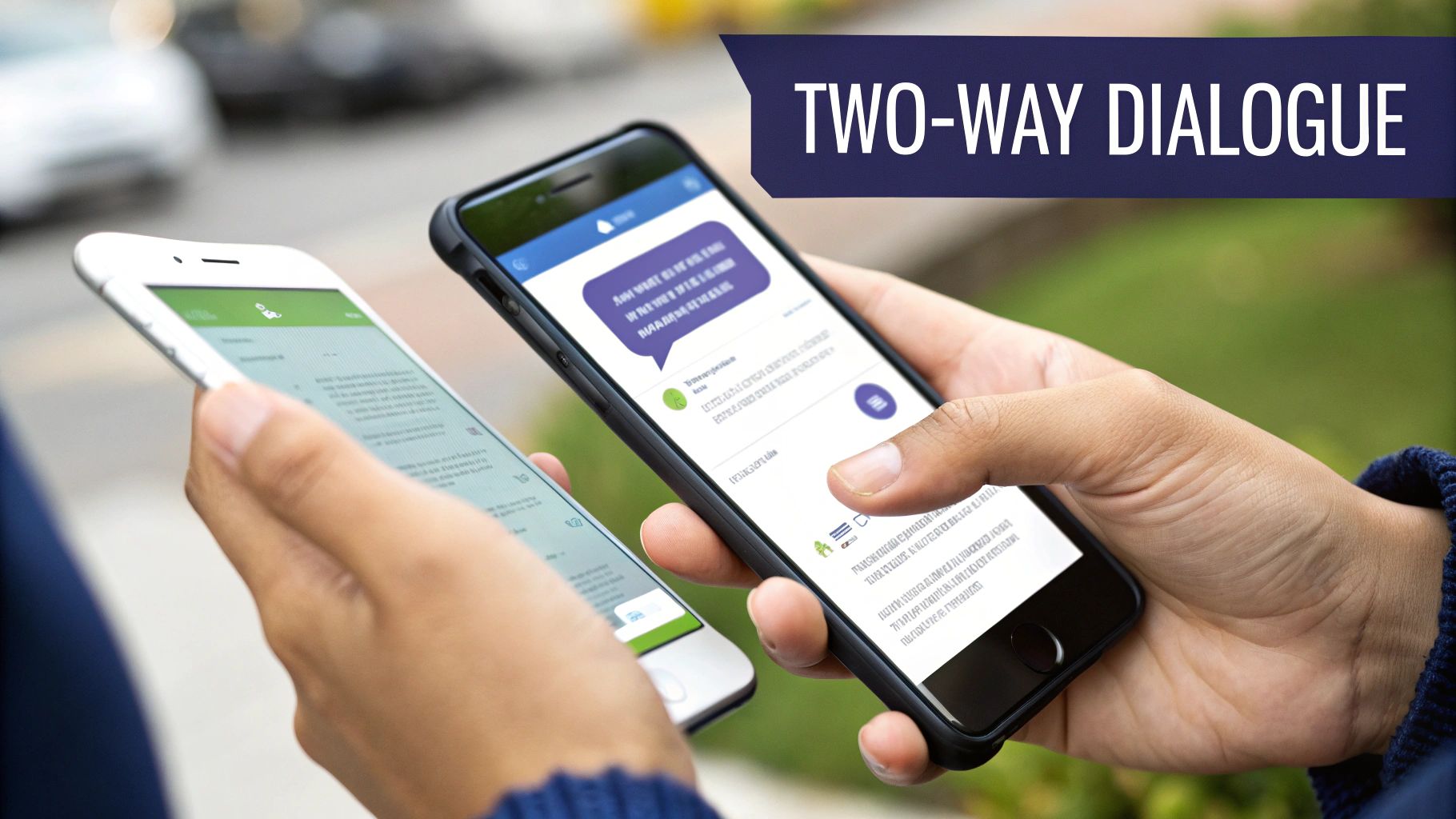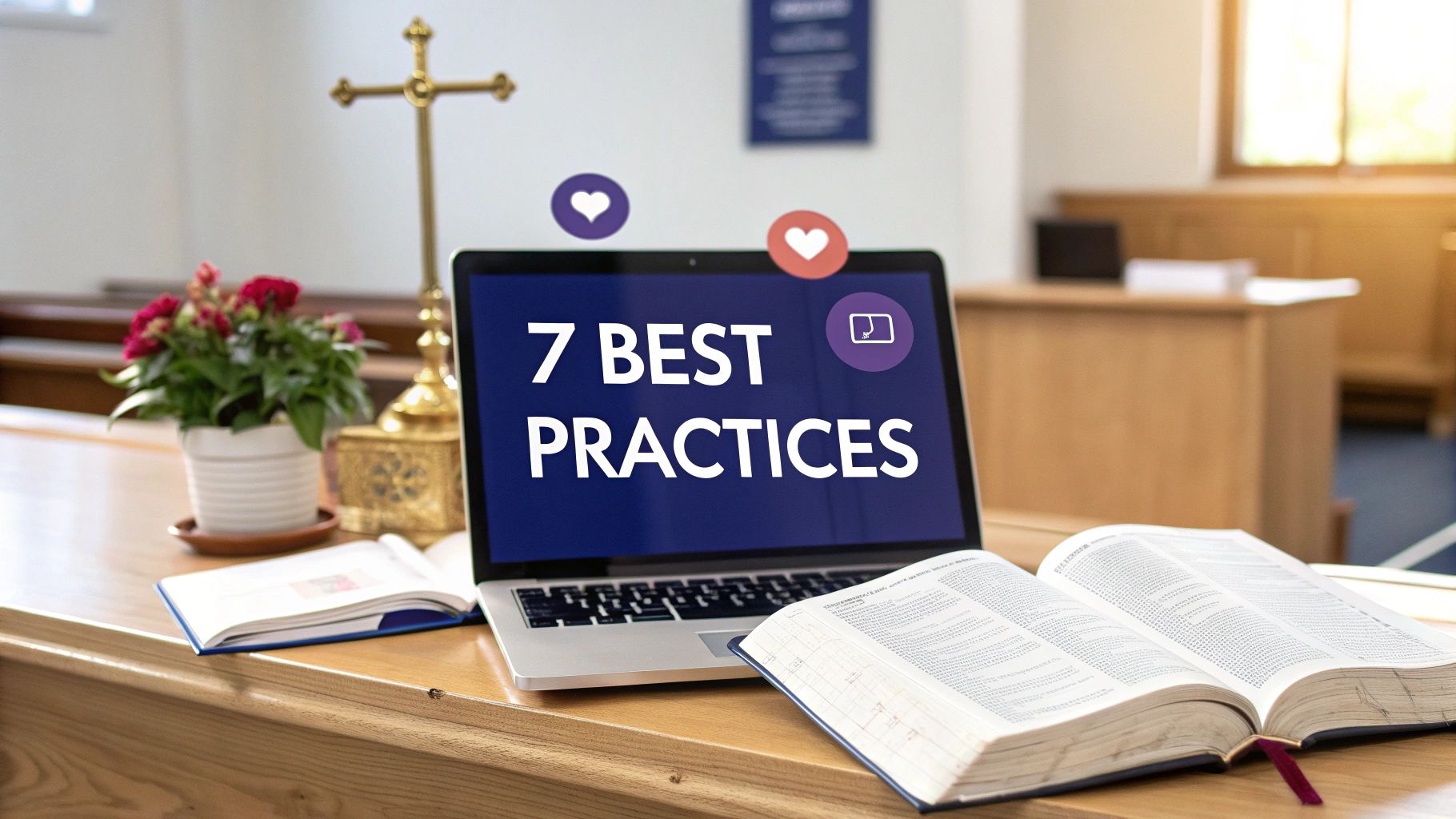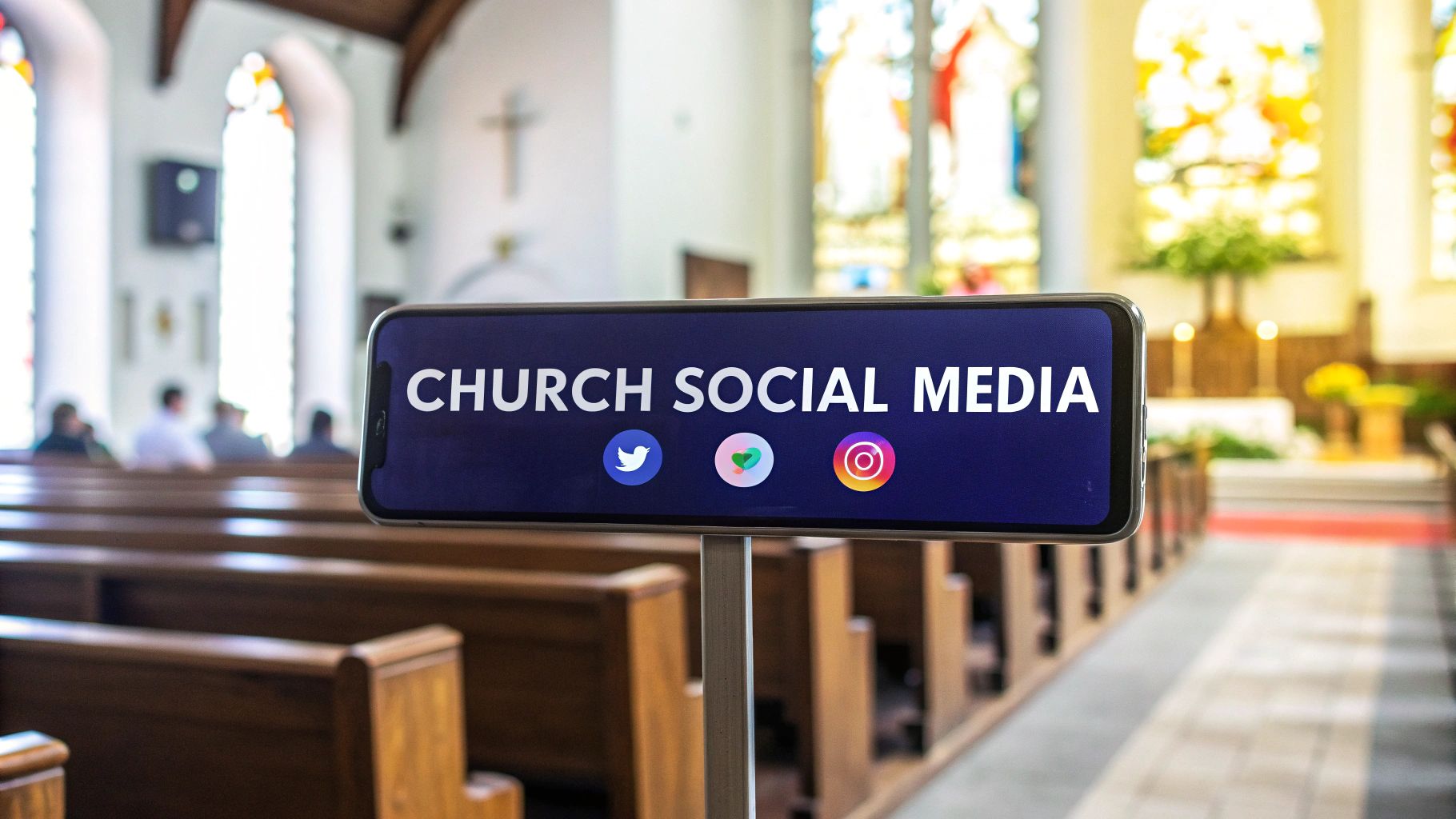Your church's community now extends far beyond its physical walls. Social media has become the new digital town square, a vital space for connection, ministry, and daily discipleship. Yet, many churches find themselves overwhelmed, struggling to keep up with the constant demand for fresh, engaging content. While churches operate with a nonprofit mindset, your unique mission to share the Gospel and build community requires a specialized approach. This guide is designed to cut through the noise and demystify the process by adapting proven social media best practices specifically for your ministry's context.
We will explore seven actionable strategies that will help you effectively engage your congregation, reach new seekers in your area, and amplify your message with clarity and purpose. Moving beyond simple event announcements, you will learn how to foster genuine two-way dialogue, share impactful stories, and build a vibrant online community that reflects your church's heart.
This isn't about adding more to your plate; it's about working smarter. The principles outlined here are designed to be powerful and sustainable, especially when paired with intelligent tools. For instance, platforms like ChurchSocial.ai can streamline your entire workflow, from generating social posts and video reels directly from your sermon transcripts to designing stunning graphics and managing your content calendar with a simple drag-and-drop interface.
Whether you are a dedicated volunteer or a full-time communications director, implementing these practices will transform your social media from a weekly chore into a powerful, integrated extension of your ministry. Let's dive into the strategies that will help your church's digital outreach truly flourish.
1. Turn Sermons into Shareable Stories with Visual Content
Your Sunday sermon is the spiritual centerpiece of your weekly ministry, rich with insight and encouragement. However, its impact shouldn't be confined to the sanctuary walls. One of the most effective social media best practices for churches is to extend the life of your sermon by transforming its core message into compelling, visual social media content.
This practice involves deconstructing a 30-40 minute sermon into bite-sized, shareable assets like video clips, quote graphics, and multi-slide carousels. Instead of simply posting a link to the full recording, you meet your community where they are: scrolling through their feeds. This strategy makes your teachings more accessible and emotionally resonant, reinforcing the message for your congregation throughout the week and reaching a new audience that may have never attended a service.
Why This Approach Works for Churches
Sermon-based content is authentic and mission-aligned, providing a steady stream of valuable posts without requiring you to invent new topics. It directly reflects your church's voice and theological foundation, building a cohesive and trustworthy online presence. By presenting your message in visually engaging formats, you make profound truths easy to digest, remember, and share.
Actionable Steps for Implementation
Transforming a sermon into a week's worth of content is simpler than it sounds, especially with the right tools. Platforms like ChurchSocial.ai are designed specifically for this purpose, using AI to streamline the entire process.
- Create AI-Generated Reels: The most powerful sermon moments can become captivating short-form videos. Use a tool that can analyze your sermon audio or video and automatically identify powerful, shareable segments. ChurchSocial.ai can generate these reels for you, complete with animated captions to engage viewers watching without sound.
- Design Quote Graphics & Carousels: Pull out a single impactful sentence or key takeaway from the sermon. Use a user-friendly editor with pre-made templates, like those in ChurchSocial.ai, to create visually appealing graphics. For more complex points, use a carousel format to break down a concept into a step-by-step guide or a list of three key insights.
- Repurpose Transcripts for Deeper Content: Your sermon transcript is a goldmine. For greater accessibility and to improve your website's SEO, you can learn how to transcribe your YouTube videos to create text-based assets. Then, use an AI content generator like ChurchSocial.ai to turn that transcript into social media posts, small group discussion questions, or even a blog post for your church website.
Key Insight: The goal is not just to post; it's to create an echo. When a member of your congregation sees a post on Wednesday that reinforces Sunday's message, it deepens their connection and helps the teaching take root in their daily life.
2. Foster Community with Engagement and Two-Way Dialogue
Many churches approach social media as a digital announcement board, broadcasting information one way. However, a core social media best practice for ministry is to transform this one-way street into a bustling town square. This means actively fostering conversations, responding to comments, and creating opportunities for your congregation and community to interact with your church and each other.
This practice shifts your social media from being a simple broadcast tool to a powerful community-building platform. When you engage in genuine dialogue, you’re not just posting content; you’re ministering to people. You’re showing your community that their voices are heard and valued, which builds trust, deepens relationships, and creates a sense of belonging that extends far beyond Sunday morning.

Why This Approach Works for Churches
For a church, community is everything. Engaging in two-way dialogue online is a digital extension of your ministry of presence. It creates a welcoming environment where new visitors feel comfortable asking questions and members can share prayer requests or celebrate praises. This active engagement humanizes your church, making it more approachable and reflective of the relational nature of the body of Christ.
Actionable Steps for Implementation
Building a vibrant online community requires intentionality and consistent effort. Planning your engagement strategy is just as important as planning your content calendar, and tools can help streamline this vital ministry task.
- Ask Engaging Questions: Don't just post announcements. Create posts that invite responses. Ask questions like, "What was your biggest takeaway from Sunday's message?" or "How can we be praying for you this week?" ChurchSocial.ai can help you generate these conversation-starting captions directly from your sermon transcript, ensuring your questions are relevant and thought-provoking.
- Respond Promptly and Personally: Aim to reply to comments and direct messages as quickly as possible, ideally within a few hours during the day. Acknowledge each person by name and offer a thoughtful response, not just a generic "Thanks!" This shows you genuinely care and are paying attention.
- Celebrate Your Community: Spotlight volunteers, share photos from church events (with permission), and celebrate milestones within your congregation. Use your platform to make people feel seen and appreciated. Platforms with integrated calendars, like ChurchSocial.ai, can help you plan and schedule these posts around key church events and dates.
- Set Clear Guidelines: Establish a social media style guide that outlines your church's voice and tone for responding to various types of comments, from simple encouragement to difficult theological questions. This ensures consistency, even if multiple people are managing the accounts. For more tips, you can explore strategies for building community online with ChurchSocial.ai.
Key Insight: Every comment, like, and share is an opportunity for ministry. Treating social media as a conversation, not a monologue, transforms your followers from a passive audience into an active, engaged online congregation.
3. Develop a Mission-Driven Content Strategy
Your social media feed should be a direct reflection of your church's unique mission and purpose. A mission-driven content strategy goes beyond simply announcing service times or events; it’s a plan that consistently reinforces your core beliefs, values, and impact. This approach ensures every post serves a purpose, whether it's to educate, inspire, or build community, creating a feed that feels authentic and spiritually nourishing.
This practice involves creating content pillars that align directly with your ministry's key focus areas, such as community outreach, spiritual growth, or family ministry. Instead of posting reactively, you build a content calendar that proactively tells the story of your church's identity. This strategy transforms your social media from a simple bulletin board into a powerful ministry tool that nurtures your congregation and attracts new members who resonate with your vision.

Why This Approach Works for Churches
A mission-driven strategy provides clarity and consistency, which are crucial for building trust online. It prevents your feed from becoming a random assortment of posts and instead weaves a cohesive narrative about who you are as a church. This is one of the most vital social media best practices because it ensures your online presence is a genuine extension of your in-person ministry, providing value to followers far beyond Sunday morning.
Actionable Steps for Implementation
Creating a robust content strategy is essential for long-term growth and engagement. When developing your mission-driven content strategy, it's invaluable to consult a comprehensive social media marketing strategy playbook to ensure a cohesive and impactful approach. Platforms like ChurchSocial.ai can then help you execute this plan with ease.
- Define Your Content Pillars: Identify 3-5 core themes that stem directly from your church's mission statement. Examples could include "Biblical Teaching," "Community Service," "Worship & Prayer," and "Family Life." These pillars will guide all your content creation efforts.
- Build a Content Calendar: Use a simple drag-and-drop calendar, like the one in ChurchSocial.ai, to plan your posts around these pillars. Assign specific days for certain themes, such as "Mission Monday" or "Testimony Tuesday," to create a predictable and engaging rhythm for your audience.
- Integrate Church Events Seamlessly: A key part of your mission is bringing people together. Connect your Planning Center or other church calendar directly to a tool like ChurchSocial.ai to automatically generate promotional posts for upcoming events, small groups, and volunteer opportunities, ensuring your content is always timely and relevant. Discover more about creating a powerful social media strategy for your church.
Key Insight: Your mission is your North Star. A content strategy aligned with that mission ensures every post, story, and video works together to communicate God's work in your community, making your social media an authentic and effective outreach tool.
4. Strategic Platform Selection and Optimization
Many churches feel the pressure to be active on every social media platform, but a scattered presence is rarely an effective one. A cornerstone of successful social media best practices for ministry is to focus your efforts where your community actually is. Strategic platform selection means choosing the social media channels where your target congregants and community members are most active and optimizing your content for each platform’s unique audience and features.
This approach prioritizes depth over breadth. Instead of stretching your limited time and resources thin across five different platforms, you can build a thriving, engaged community on one or two. By understanding that what resonates on Facebook (community updates and event invitations) differs from what works on Instagram (inspirational visuals and sermon Reels), you can tailor your message for maximum impact and build a more meaningful online ministry.

Why This Approach Works for Churches
A focused strategy allows your church to cultivate a genuine community rather than just broadcasting announcements. When you master a platform, you learn its nuances, algorithms, and user expectations, which leads to higher engagement and a stronger connection with your members. This intentionality ensures your online presence authentically reflects your church's mission and effectively serves your congregation where they spend their digital lives.
Actionable Steps for Implementation
Choosing and optimizing your platforms requires a thoughtful, data-informed process, but it leads to a more sustainable and impactful social media ministry. Tools with built-in scheduling and content management can simplify this process significantly.
- Survey Your Congregation: The simplest way to know where your church members are is to ask them. Use a quick Sunday morning poll, an email survey, or a social media story to find out which platforms they use most frequently to connect with friends, family, and organizations.
- Analyze Your Demographics: Different platforms attract different age groups. Facebook is often popular with older members and families, while Instagram and TikTok tend to skew younger. Choose the platforms that best align with the demographics of the people you want to reach, both inside and outside your church walls.
- Start Small and Master One Platform: Begin with the one platform where most of your congregation is active. Focus on consistently posting high-quality, engaging content. Use a tool like ChurchSocial.ai to simplify your workflow with sermon-based Reels, AI-generated posts, and beautiful graphic templates. A robust plan is key; you can get started with a social media calendar template to organize your content and ensure consistency.
- Optimize Content for Each Channel: Once you expand, never just copy and paste. A sermon clip might be a 60-second Reel on Instagram, a longer video on Facebook, and a series of quote graphics on both. Leverage the native features of each platform, like Instagram Stories polls or Facebook Events, to create tailored experiences.
Key Insight: Being everywhere means being effective nowhere. True digital ministry isn't about platform quantity; it's about the quality of connection you build on the right platforms. Choose wisely, go deep, and watch your online community flourish.
5. Authentic Transparency and Impact Reporting
In an era where trust is paramount, one of the most powerful social media best practices a church can adopt is radical transparency. This means openly sharing how your congregation's tithes and offerings are being used to fulfill your ministry's mission, from local outreach projects to global missions. It's about pulling back the curtain and showing the tangible impact of generosity.
This practice involves regularly reporting on your church’s activities, financials, and outcomes in a way that is clear, honest, and accessible. Instead of simply mentioning a "successful food drive," you share the specific numbers: "Because of your generosity, we provided 500 meals to families in our community this month." This level of detail transforms abstract support into concrete, celebrated results, fostering a deeper sense of ownership and connection among your members.
Why This Approach Works for Churches
For a church, transparency isn't just a strategy; it's a reflection of biblical stewardship and integrity. When you openly share both successes and the occasional challenge, you build a foundation of trust that is unshakable. This accountability demonstrates that you value every single contribution and are committed to using resources wisely, which in turn encourages greater and more consistent giving.
Actionable Steps for Implementation
Showcasing your impact doesn't require a dedicated accounting team; it just requires a commitment to communication and the right tools to make it simple. Platforms like ChurchSocial.ai can help you create and schedule this content seamlessly.
- Create Quarterly Impact Reports: Design a simple, visually engaging template for a quarterly impact report. You can use the graphic templates and editor in ChurchSocial.ai to create a beautiful carousel post. Dedicate slides to key areas like local outreach, missions support, and community events, showcasing both numbers and personal stories.
- Share Real-Time Updates: Did your youth group just complete a service project? Did a mission partner send an update from the field? Share these stories as they happen. Use a quick photo or video to capture the moment and share the immediate results of your congregation's efforts. This keeps your ministry's work top-of-mind.
- Visualize Financial Stewardship: Make financial data easy to understand. Instead of a dense spreadsheet, create a simple infographic or pie chart showing the percentage of your budget allocated to ministry, operations, and outreach. To truly build trust and demonstrate your impact, it's essential to master social media campaign reporting to present this data effectively.
Key Insight: Transparency is the antidote to donor skepticism. When people can clearly see the line from their contribution to a life changed, their motivation to give moves from a sense of obligation to a spirit of joyful partnership in the ministry's mission.
6. Foster Community Amplification with User-Generated Content
Your congregation is your most powerful advocate. Their stories of faith, transformation, and community involvement are more authentic and relatable than any post you could create. Tapping into this is a core tenet of social media best practices for churches: actively encouraging and showcasing user-generated content (UGC).
This practice involves creating opportunities for your members to share their own photos, videos, and testimonials related to church life. From a baptism celebration to a small group service project or a simple moment of reflection inspired by a sermon, UGC turns your congregation from a passive audience into active participants in your church's digital ministry. It's about building a shared narrative and letting your community's genuine experiences speak for themselves.
Why This Approach Works for Churches
User-generated content builds powerful social proof and a deep sense of belonging. When potential visitors see real people actively engaged and finding joy in your church community, it breaks down barriers and makes your ministry more approachable. This strategy also provides a rich, diverse stream of content that reflects the true spirit of your congregation, saving your team time while dramatically increasing authenticity and engagement.
Actionable Steps for Implementation
Creating a culture where members feel excited to share their experiences is key. The right strategy and tools can make this process seamless and effective, turning your social media feed into a vibrant reflection of your church family.
- Create Clear & Memorable Hashtags: Launch specific hashtags for events, sermon series, or ongoing initiatives (e.g., #OurChurchServes, #MyChurchHome, #SundayReflections). Promote these hashtags from the pulpit, in your bulletin, and on social media, making it easy to find and share member posts.
- Run a UGC-Focused Campaign: Ask your congregation to share photos or short videos answering a specific prompt, like "What does community mean to you?" or "Share a photo from your favorite church event." This creates a unified and impactful collection of stories.
- Always Ask for Permission & Give Credit: Before reposting any content, send a direct message to the original creator asking for their permission. When you share it, always tag and credit their account in the caption. This simple act of respect builds trust and encourages more people to share in the future.
- Feature Diverse Voices: Be intentional about showcasing a wide range of stories from different demographics within your church. This ensures your online presence accurately reflects the beautiful diversity of your entire congregation and makes everyone feel seen and valued.
Key Insight: User-generated content transforms your social media from a monologue into a conversation. It shifts the focus from the church organization to the church body, creating a powerful, community-owned platform that celebrates shared faith and experiences.
7. Crisis Communication and Real-Time Response
In an always-on digital world, your church’s social media is often the first place your community turns for information during a crisis. Whether it's a local emergency, a national event affecting your congregation, or an internal issue requiring a delicate response, having a plan is crucial. This essential social media best practice involves establishing protocols for addressing urgent situations with clarity, compassion, and speed.
This practice means you aren't starting from scratch when a crisis hits. It involves creating a proactive plan for how your church will communicate, who is authorized to speak, and what key messages need to be conveyed. Instead of reacting with uncertainty, your team can respond with confidence, providing timely and accurate information that reassures your congregation and maintains trust.
Why This Approach Works for Churches
A church is a place of refuge and leadership, especially in difficult times. A well-executed crisis communication plan reinforces this role, showing your community that you are a reliable source of support and guidance. It prevents misinformation from spreading, manages the narrative, and demonstrates responsible stewardship of your ministry’s reputation, ensuring your online presence remains a source of hope, not confusion.
Actionable Steps for Implementation
Preparing for a crisis before it happens is the key to navigating it successfully. A centralized platform can help your team coordinate and execute your plan efficiently, even under pressure.
- Develop a Crisis Playbook: Don't wait for an emergency. Outline potential scenarios relevant to your church (e.g., severe weather, community tragedy, negative comments) and create step-by-step response guides for each. Define roles, identify key spokespeople, and establish a clear approval chain for all public statements.
- Prepare Holding Statements: In the initial moments of a crisis, you may not have all the answers. Prepare pre-approved, template-based "holding statements" that acknowledge the situation, express empathy, and inform your audience that you are gathering more information. You can store these templates in your ChurchSocial.ai content library for immediate access.
- Use a Centralized Calendar for Coordination: When a situation develops, your communication must be coordinated across all platforms. Use a drag-and-drop calendar, like the one in ChurchSocial.ai, to pause all pre-scheduled content instantly. This prevents a cheerful, automated post about an upcoming event from appearing during a serious moment. The calendar then becomes your command center for scheduling and deploying crisis-related updates.
Key Insight: Your response during a crisis is a powerful reflection of your ministry's values. A calm, compassionate, and organized social media presence can provide immense comfort and stability to a community in need, reinforcing your church's role as a spiritual anchor.
7-Key Best Practices Comparison
Unify Your Ministry's Message with ChurchSocial.ai
Navigating the dynamic world of social media can often feel like a full-time ministry in itself. Throughout this guide, we've explored the essential pillars of a thriving digital presence for your church. From harnessing the power of visual storytelling and fostering genuine two-way dialogue to anchoring your content in your core mission, these social media best practices are the building blocks for impactful online outreach. We've seen how strategic platform selection, authentic reporting on your ministry's impact, and amplifying community voices through user-generated content can transform passive followers into an engaged digital congregation.
Yet, understanding these principles is one thing; implementing them consistently is another challenge entirely, especially with limited time, resources, and volunteer support. The key isn't just knowing what to do, but having the right system in place to do it effectively and without burnout. Your church’s message is too important to be hindered by complex workflows or a lack of creative tools.
Bridging Strategy and Execution
The true power of these best practices is unlocked when they move from a checklist to a cohesive, integrated strategy. Think of your social media not as a series of disconnected posts, but as a unified extension of your ministry.
- Storytelling and Mission Alignment: Every reel, graphic, and caption should echo your church’s unique mission. An effective strategy ensures that the story you tell visually aligns perfectly with the spiritual foundation you're building.
- Engagement and Community: Authentic engagement isn't just about responding to comments. It's about creating content that invites conversation, encourages sharing, and makes your online space feel like a welcoming community hub.
- Transparency and Amplification: When you transparently share the impact of a mission trip or a community outreach event, you're not just reporting facts. You are providing powerful source material for user-generated content, inviting your congregation to share their own experiences and become your most passionate advocates.
This holistic approach transforms your social media channels from a simple announcement board into a vibrant ecosystem of faith, connection, and outreach. It’s where your mission comes to life online.
From Overwhelmed to Empowered
The most significant barrier for most church communicators is the sheer amount of work required to maintain this level of quality and consistency. Juggling sermon recordings, event promotions, graphic design, and daily posting can quickly lead to exhaustion. This is precisely where a dedicated tool like ChurchSocial.ai can make all the difference, turning a daunting task into a manageable and even joyful one.
Imagine effortlessly transforming last Sunday's sermon into a dozen engaging social media posts. Picture a system that pulls your event details directly from Planning Center and helps you generate compelling promotional content in minutes. With ChurchSocial.ai, you get AI-generated reels and posts from your sermons, a full suite of graphic templates and an editor for stunning visuals, and a simple drag-and-drop calendar to manage it all. By automating the repetitive tasks, you free up invaluable time and mental energy to focus on the heart of your digital ministry: building relationships and sharing the message of hope.
This is the future of effective church communication. It's not about working harder; it's about working smarter, equipped with a platform designed to understand and serve the unique needs of your ministry. By embracing these social media best practices and leveraging the right technology, you can amplify your church's voice, deepen your community's connection, and extend your reach far beyond your physical walls.
Ready to unify your strategy and simplify your workflow? ChurchSocial.ai is the all-in-one platform built specifically for churches, helping you implement these best practices with ease. Transform your sermons into reels, generate content with AI, and manage your entire social media calendar from one simple dashboard by visiting ChurchSocial.ai to start your trial today.



